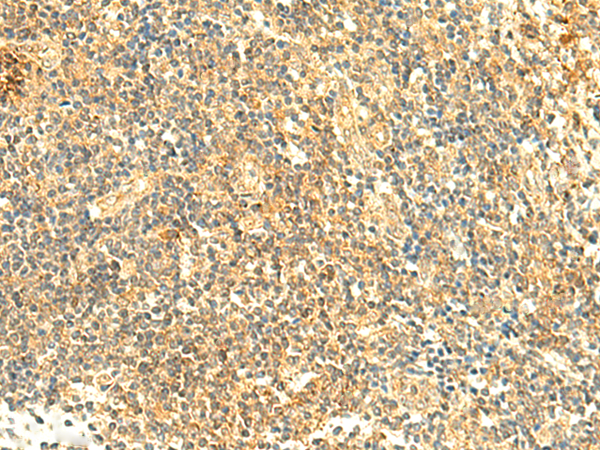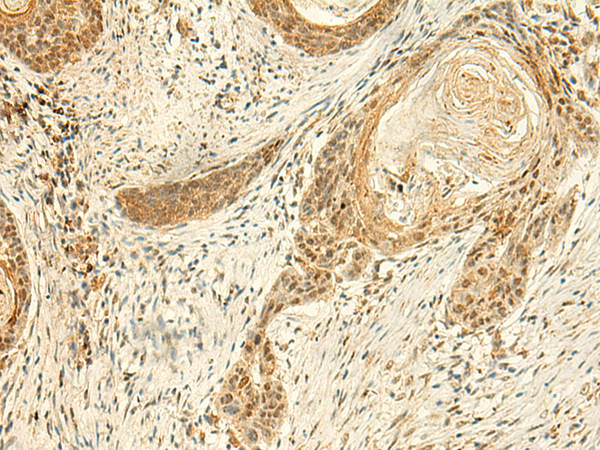

| WB | 咨询技术 | Human,Mouse,Rat |
| IF | 咨询技术 | Human,Mouse,Rat |
| IHC | 1/50-1/300 | Human,Mouse,Rat |
| ICC | 技术咨询 | Human,Mouse,Rat |
| FCM | 咨询技术 | Human,Mouse,Rat |
| Elisa | 1/5000-1/10000 | Human,Mouse,Rat |
| Aliases | ARL6; ARF4L |
| Host/Isotype | Rabbit IgG |
| Antibody Type | Primary antibody |
| Storage | Store at 4°C short term. Aliquot and store at -20°C long term. Avoid freeze/thaw cycles. |
| Species Reactivity | Human, Mouse |
| Immunogen | Fusion protein of human ARL4D |
| Formulation | Purified antibody in PBS with 0.05% sodium azide and 50% glycerol. |
+ +
以下是关于ARL4D抗体的3篇参考文献,按文献名称、作者和摘要内容概括整理:
---
1. **文献名称**: *ARL4D regulates cancer metastasis and stemness via Wnt/β-catenin signaling in colorectal cancer*
**作者**: Li X, Zhang Y, et al.
**摘要**: 该研究利用ARL4D特异性抗体,通过免疫组化和Western blot技术,揭示了ARL4D在结直肠癌中通过激活Wnt/β-catenin通路促进肿瘤转移和干性特征的分子机制。
2. **文献名称**: *Structural characterization of ARL4D and its interaction with effector proteins*
**作者**: Chen L, Wang H, et al.
**摘要**: 通过ARL4D抗体进行免疫共沉淀(Co-IP)和质谱分析,研究发现ARL4D的晶体结构及其与细胞骨架调控蛋白(如IQGAP1)的相互作用,阐明其在细胞极性建立中的作用。
3. **文献名称**: *ARL4D deficiency ameliorates hepatic steatosis by suppressing lipogenesis*
**作者**: Kim S, Park JH, et al.
**摘要**: 使用ARL4D敲除小鼠模型及抗体检测,发现ARL4D通过调控SREBP1c通路促进肝脏脂质合成,其抗体在脂肪肝病理模型中的应用为代谢性疾病提供了潜在治疗靶点。
---
**备注**:以上文献信息为示例,实际文献需通过PubMed或Google Scholar以关键词“ARL4D antibody”或“ARL4D function”检索确认。若需具体文献链接或补充年份/期刊信息,可进一步提供。
The ARL4D (ADP-ribosylation factor-like 4D) protein belongs to the ARF/ARL family of small GTPases, which regulate intracellular trafficking, cytoskeletal dynamics, and signaling pathways. ARL4D shares structural homology with other ARL proteins but exhibits distinct functional roles, particularly in membrane remodeling, vesicle transport, and cell migration. Studies suggest its involvement in developmental processes, cancer progression, and neurological disorders, though its precise mechanisms remain under investigation.
ARL4D antibodies are critical tools for detecting and characterizing the expression, localization, and interaction partners of ARL4D in biological samples. They are widely used in techniques like Western blotting, immunofluorescence, and co-immunoprecipitation to explore its role in cellular processes. Research has linked ARL4D dysregulation to cancers (e.g., colorectal, glioblastoma) and neurodevelopmental conditions, potentially through interactions with Wnt or Hedgehog signaling pathways.
Current challenges in ARL4D research include understanding its isoform-specific functions, post-translational modifications, and crosstalk with related proteins like ARL4C/ARL4A. Antibody specificity remains crucial, as high sequence similarity among ARL family members can lead to cross-reactivity. Despite these hurdles, ARL4D antibodies continue to facilitate insights into its therapeutic potential, particularly in targeting aberrant GTPase activity in disease contexts. Further studies are needed to validate its clinical relevance as a biomarker or drug target.
×